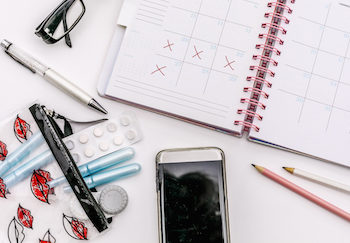
When it comes to birth control, we’ve come a long way since the Pill was introduced in 1960. Women have more options than ever to prevent pregnancy. Yet, some women still rely on the rhythm method. That is, they turn to their calendars – not their medicine cabinets – for birth control.
“Natural family planning has been around forever,” says OB-GYN Carrie Sopata, MD. “It’s a good option for women who are sensitive to hormones or for those with religious objections to birth control.”
The question is: Does this old-school approach to birth control really work?
What is the Rhythm Method?
The rhythm method requires you to carefully monitor your menstrual cycle. You can then identify when you’re most fertile and likely to get pregnant. You’re most fertile right before you ovulate, as your body releases an egg into the uterus where it can easily be fertilized. To prevent pregnancy, you would avoid having sex or use other birth control during this time.
Several apps can make it easy to track your period and know when ovulation occurs. In fact, the U.S. Food and Drug Administration just approved an app as a form of birth control.
Unfortunately, the rhythm method is still only around 75% effective for preventing pregnancy. By comparison, the IUD is 99.7% effective.
Using the Rhythm Method to Help You Conceive
Most women today use the rhythm method in order to get pregnant, not to prevent a pregnancy, says Sopata. To make the rhythm method most effective for pregnancy planning, women must use a variety of techniques to pinpoint when they ovulate.
Tips to Make the Rhythm Method More Effective
Count the Days of Your Menstrual Cycle
Most women have a cycle between 21 and 35 days. Ovulation occurs 14 days before the menstruation, so in a 28-day cycle, it occurs right in the middle on day 14.
However, some women see some variation in their cycle month to month. Keeping track for an extended period of time can help you get a clear picture of when you ovulate. “Typically, it takes 3 to 5 months before you have a good idea of when you ovulate,” says Sopata.
Measure Your Basal Body Temperature
Your basal body temperature is your temperature at rest. “You should measure your temperature before you get out of bed each morning,” says Sopata. “Typically, this is around 97 to 98 degrees, but everyone is different.” After you ovulate, your temperature will increase half a degree. “When you see your temperature rise, you know you’re ovulating,” says Sopata.
Ready to Plan Your Family?
Make an appointment today with a UVA women’s health specialist.
Monitor Cervical Mucus
Vaginal discharge commonly occurs throughout the month. During ovulation, however, your cervical mucus changes. You’ll see stretchy, clear discharge, similar to an egg white. This could mean that pregnancy is possible.
What if Your Cycle isn’t Regular?
If you’ve tried tracking your period for several months, but still can’t get a clear picture of when your cycle ends and begins, talk to your doctor. “Irregular cycles can be a sign of a more serious condition, like premature menopause or polycystic ovarian syndrome,” says Sopata.
